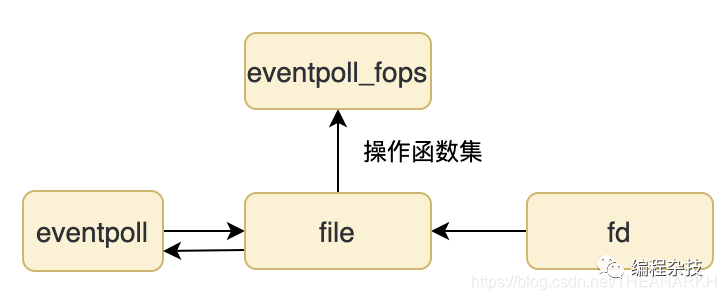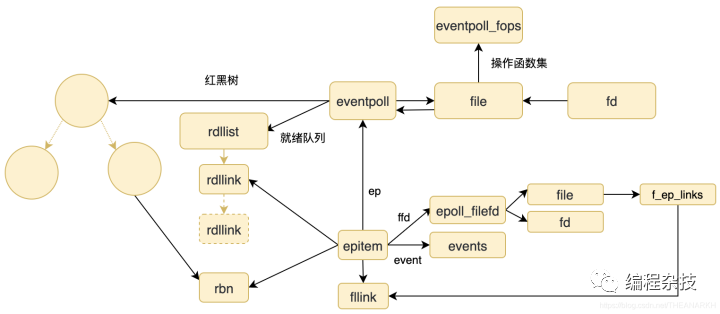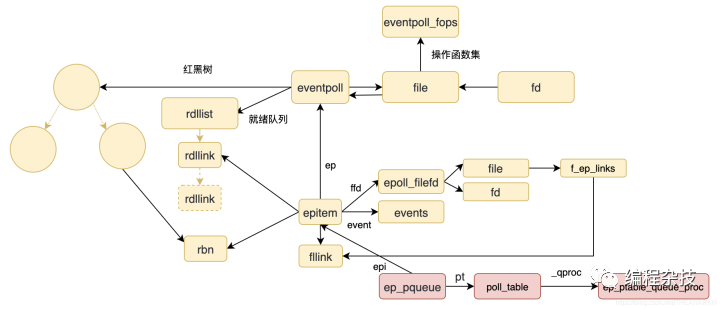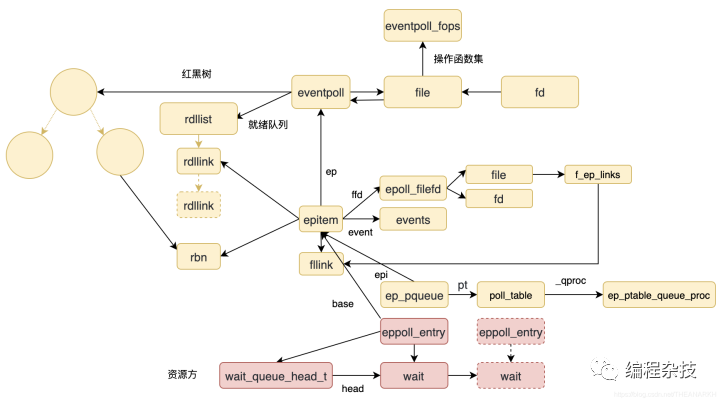epoll是现代服务器的基石,也是高效处理大量请求的利器,从设计上来看,epoll的设计思想也是非常优秀的,本文介绍epoll的实现,从中我们不仅看到epoll的实现原理和机制,同时也能领略到其中优秀的设计思想。
epoll的使用非常简单,主要是几个API,下面我们一个个分析。
1 epoll_create
epoll_create是创建epoll实例的API,对使用方来说,epoll是一个黑盒子,我们通过操作系统提供的API,拿到一个实例(黑盒子)之后,就可以往里面注册我们想要监听的fd和事件,条件满足的时候,epoll就会通知我们,下面我们看看epoll_create的实现。
- SYSCALL_DEFINE1(epoll_create1, int, flags){
- return do_epoll_create(flags);
- }
- SYSCALL_DEFINE1(epoll_create, int, size){
- if (size <= 0)
- return -EINVAL;
- return do_epoll_create(0);
- }
我们看到epoll_create有两个版本,其中epoll_create1多支持了flags参数,比如设置非阻塞模式,两个API具体的区别不大。接下来我们看do_epoll_create。
- static int do_epoll_create(int flags){
- int error, fd;
- struct eventpoll *ep = NULL;
- struct file *file;
- // 只支持CLOEXEC
- if (flags & ~EPOLL_CLOEXEC)
- return -EINVAL;
- // 分配一个eventpoll
- error = ep_alloc(&ep);
- // 获取一个空闲文件描述符
- fd = get_unused_fd_flags(O_RDWR | (flags & O_CLOEXEC));
- // 获取一个file,并且关联eventpoll_fops和上下文ep
- file = anon_inode_getfile("[eventpoll]", &eventpoll_fops, ep, O_RDWR | (flags & O_CLOEXEC));
- // ep和file关联起来,上面是file和ep关联
- ep->file = file;
- // 关联fd和file
- fd_install(fd, file);
- return fd;
- }
我们看到do_epoll_create的实现非常简单,主要是创建了一个eventpoll结构体,eventpoll结构体比较复杂。下面列出核心的字段。
- struct eventpoll {
- struct mutex mtx;
- // 阻塞在该epoll的进程队列
- wait_queue_head_t wq;
- // 当epoll被另一个epoll监听时需要使用poll_wait记录阻塞在该epoll的队列
- wait_queue_head_t poll_wait;
- // 就绪队列
- struct list_head rdllist;
- rwlock_t lock;
- // 红黑树根节点
- struct rb_root_cached rbr;
- // 记录epitem的单链表
- struct epitem *ovflist;
- struct wakeup_source *ws;
- // 创建该epoll的用户信息
- struct user_struct *user;
- // epoll对应的file
- struct file *file;
- };
创建了一个eventpoll结构体后,接着申请了一个file和fd,并且把file和eventpoll关联起来,主要的作用是调用方后续可以通过fd操作eventpoll,架构如下。
2 epoll_ctl
epoll_ctl是操作epoll的总入口,也是非常复杂的开始,但是简单来说就是增删改的接口。
- SYSCALL_DEFINE4(epoll_ctl, int, epfd, int, op, int, fd,
- struct epoll_event __user *, event){
- struct epoll_event epds;
- // 判断是否需要复制数据,如果是删除则不需要,根据fd删除就行
- if (ep_op_has_event(op) &&
- copy_from_user(&epds, event, sizeof(struct epoll_event)))
- return -EFAULT;
- return do_epoll_ctl(epfd, op, fd, &epds, false);
- }
epoll_ctl是对do_epoll_ctl的封装。
- // 操作epoll
- int do_epoll_ctl(int epfd, int op, int fd, struct epoll_event *epds,
- bool nonblock){
- int error;
- int full_check = 0;
- struct fd f, tf;
- struct eventpoll *ep;
- struct epitem *epi;
- struct eventpoll *tep = NULL;
- error = -EBADF;
- // 根据fd找到对应的数据结构
- f = fdget(epfd);
- // 获取被操作的文件描述符的数据结构
- tf = fdget(fd);
- error = -EPERM;
- // 资源有没有实现poll接口,使用epoll监听的资源需要实现poll钩子
- if (!file_can_poll(tf.file))
- goto error_tgt_fput;
- error = -EINVAL;
- // 保证被操作的fd不是自己,并且自己是epoll
- if (f.file == tf.file || !is_file_epoll(f.file))
- goto error_tgt_fput;
- // 根据fd找到epoll数据结构
- ep = f.file->private_data;
- // 加锁
- epoll_mutex_lock(&ep->mtx, 0, nonblock);
- // 判断fd是否已经存在epoll的红黑树中
- epi = ep_find(ep, tf.file, fd);
- error = -EINVAL;
- switch (op) {
- // 新增
- case EPOLL_CTL_ADD:
- // 之前没有则可以新增,否则报错
- if (!epi) {
- epds->events |= EPOLLERR | EPOLLHUP;
- // 插入epoll
- error = ep_insert(ep, epds, tf.file, fd, full_check);
- } else
- error = -EEXIST;
- break;
- // 删除
- case EPOLL_CTL_DEL:
- // 存在则删除,否则报错
- if (epi)
- error = ep_remove(ep, epi);
- else
- error = -ENOENT;
- break;
- // 修改
- case EPOLL_CTL_MOD:
- // 存在则修改,否则报错
- if (epi) {
- if (!(epi->event.events & EPOLLEXCLUSIVE)) {
- epds->events |= EPOLLERR | EPOLLHUP;
- error = ep_modify(ep, epi, epds);
- }
- } else
- error = -ENOENT;
- break;
- }
- return error;
- }
我们看到do_epoll_ctl主要首先通过两个fd拿到对应的epoll和资源,然后做了一些校验,接着根据操作类型做进一步处理,操作类型有增删改,我们只需要分析插入就行,这是epoll核心。
- static int ep_insert(struct eventpoll *ep, const struct epoll_event *event,
- struct file *tfile, int fd, int full_check){
- int error, pwake = 0;
- __poll_t revents;
- long user_watches;
- struct epitem *epi;
- struct ep_pqueue epq;
- lockdep_assert_irqs_enabled();
- // 监听的文件描述符个数
- user_watches = atomic_long_read(&ep->user->epoll_watches);
- // 超了
- if (unlikely(user_watches >= max_user_watches))
- return -ENOSPC;
- // 分配一个epitem
- if (!(epi = kmem_cache_alloc(epi_cache, GFP_KERNEL)))
- return -ENOMEM;
- // 初始化
- INIT_LIST_HEAD(&epi->rdllink);
- INIT_LIST_HEAD(&epi->fllink);
- INIT_LIST_HEAD(&epi->pwqlist);
- // 所属的epoll
- epi->ep = ep;
- // 保存fd和file
- ep_set_ffd(&epi->ffd, tfile, fd);
- // 记录订阅事件
- epi->event = *event;
- epi->nwait = 0;
- epi->next = EP_UNACTIVE_PTR;
- spin_lock(&tfile->f_lock);
- // 把epi插入所属file的队列
- list_add_tail_rcu(&epi->fllink, &tfile->f_ep_links);
- spin_unlock(&tfile->f_lock);
- // 插入红黑树
- ep_rbtree_insert(ep, epi);
- error = -EINVAL;
- // 关联对应的epitem
- epq.epi = epi;
- // 初始化ep_pqueue
- init_poll_funcptr(&epq.pt, ep_ptable_queue_proc);
- // 判断是否有事件触发了
- revents = ep_item_poll(epi, &epq.pt, 1);
- error = -ENOMEM;
- write_lock_irq(&ep->lock);
- // 事件触发了,并且还没有加入就绪队列则加入
- if (revents && !ep_is_linked(epi)) {
- list_add_tail(&epi->rdllink, &ep->rdllist);
- // 等待队列非空则唤醒阻塞在该epoll的队列
- if (waitqueue_active(&ep->wq))
- wake_up(&ep->wq);
- // 一个epoll被另一个监听,唤醒主epoll
- if (waitqueue_active(&ep->poll_wait))
- pwake++;
- }
- // 一个epoll被另一个监听,唤醒主epoll
- if (pwake)
- ep_poll_safewake(ep, NULL);
- write_unlock_irq(&ep->lock);
- // 监听数加一
- atomic_long_inc(&ep->user->epoll_watches);
- return 0;
- }
插入操作的逻辑分为以下几个部分
1 分配一个epitem表示一个被epoll监听的项,插入红黑树。
2 判断当前被监听的fd订阅的事件是否触发了,即注册的时候,事件就触发了,是则插入就绪队列。
3 初始化并注册节点到资源对应的队列中。
1,2的逻辑是很自然的,执行完后的架构如下
我们重点来分析3,3也是epoll最核心的设计,也就是资源满足条件的时候是如何通知epoll的,核心代码如下。
- struct ep_pqueue epq;
- // 关联对应的epitem
- epq.epi = epi;
- // 把函数ep_ptable_queue_proc保存到epq.pt
- init_poll_funcptr(&epq.pt, ep_ptable_queue_proc);
- // 判断是否有事件触发了
- revents = ep_item_poll(epi, &epq.pt, 1);
我们看到上面代码初始化了一个ep_pqueue结构体,重点是把epitem关联到了ep_pqueue结构体中,后面会看到它的作用。我们看看ep_pqueue结构体的定义。
- typedef struct poll_table_struct {
- // 函数指针
- poll_queue_proc _qproc;
- // unsigned
- __poll_t _key;
- } poll_table;
- struct ep_pqueue {
- poll_table pt;
- struct epitem *epi;
- };
上面代码执行完之后架构如下。
初始化完后接着看ep_item_poll函数。
- static __poll_t ep_item_poll(const struct epitem *epi, poll_table *pt,
- int depth){
- struct eventpoll *ep;
- bool locked;
- pt->_key = epi->event.events;
- // 不是epoll,则执行钩子函数poll
- if (!is_file_epoll(epi->ffd.file))
- return vfs_poll(epi->ffd.file, pt) & epi->event.events;
- }
- static inline __poll_t vfs_poll(struct file *file, struct poll_table_struct *pt){
- if (unlikely(!file->f_op->poll))
- return DEFAULT_POLLMASK;
- return file->f_op->poll(file, pt);
- }
ep_item_poll的逻辑是主要是执行poll钩子函数。epoll是一种机制,支持epoll的其他模块,需要实现poll钩子函数。下面以eventfd为例。
- static __poll_t eventfd_poll(struct file *file, poll_table *wait){
- struct eventfd_ctx *ctx = file->private_data;
- __poll_t events = 0;
- u64 count;
- /*
- 核心逻辑,wqh是wait_queue_head_t结构体,即管理一个队列的结构体
- struct wait_queue_head {
- spinlock_t lock;
- struct list_head head;
- };
- */
- poll_wait(file, &ctx->wqh, wait);
- // 判断当前触发的事件
- count = READ_ONCE(ctx->count);
- if (count > 0)
- events |= EPOLLIN;
- if (count == ULLONG_MAX)
- events |= EPOLLERR;
- if (ULLONG_MAX - 1 > count)
- events |= EPOLLOUT;
- return events;
- }
eventfd的poll函数为eventfd_poll。eventfd_poll会判断当前触发的事件,如果恰好是调用方订阅的事件,则直接插入就绪队列。我们主要看poll_wait的逻辑,这是非常核心的逻辑。
- /*
- file和p参数是被监听fd对应的数据结构
- wait_address是某个模块定义的数据结构,
- 用于记录当前等待资源事件触发的节点
- */
- static inline void poll_wait(struct file * filp, wait_queue_head_t * wait_address, poll_table *p){
- if (p && p->_qproc && wait_address)
- p->_qproc(filp, wait_address, p);
- }
poll_wait简单地调用_qproc函数。如果我们还有印象的话,可能会记得这个函数是ep_ptable_queue_proc。
- // 具体的资源方调用
- static void ep_ptable_queue_proc(struct file *file, wait_queue_head_t *whead,
- poll_table *pt){
- // 获取pt关联的epitem
- struct epitem *epi = ep_item_from_epqueue(pt);
- // 分配一个eppoll_entry
- struct eppoll_entry *pwq;
- if (epi->nwait >= 0 && (pwq = kmem_cache_alloc(pwq_cache, GFP_KERNEL))) {
- // 初始化pwq,记录ep_poll_callback函数
- init_waitqueue_func_entry(&pwq->wait, ep_poll_callback);
- pwq->whead = whead;
- // 关联的epitem
- pwq->base = epi;
- // pwq插入whead队列,whead由具体资源提供,比如文件,管道,资源满足条件时会pwd对应的回调
- // 插入EPOLLEXCLUSIVE解决惊群
- if (epi->event.events & EPOLLEXCLUSIVE)
- add_wait_queue_exclusive(whead, &pwq->wait);
- else
- add_wait_queue(whead, &pwq->wait);
- // 插入关联的epi队列
- list_add_tail(&pwq->llink, &epi->pwqlist);
- epi->nwait++;
- } else {
- /* We have to signal that an error occurred */
- epi->nwait = -1;
- }
- }
ep_ptable_queue_proc申请了一个eppoll_entry结构体,定义如下。
- struct wait_queue_entry {
- unsigned int flags;
- void *private;
- wait_queue_func_t func;
- struct list_head entry;
- };
- struct eppoll_entry {
- // 插入所属epitem节点的队列
- struct list_head llink;
- // 关联的epitem
- struct epitem *base;
- // 插入资源等待队列的节点
- wait_queue_entry_t wait;
- // 指向资源等待队列的头指针所在结构体
- wait_queue_head_t *whead;
- };
ep_ptable_queue_proc申请了eppoll_entry结构体并初始化后,插入资具体功能模块定义的队列中,架构如下。
我们看到调用方往epoll注册了fd和事件,epoll并没有自己去实现检测的逻辑,而是同样地注册一个节点到对应的底层资源,等待它的通知。
3 epoll_wait
注册完fd和事件后,我们就会执行epoll_wait等待事件的触发,虽然有时候我们epoll_wait的时候,事件已经触发了,但是很多情况下,事件往往是异步触发的,比如我们发送一个网络请求,等待响应的时候,下面我们来分析实现。
- SYSCALL_DEFINE4(epoll_wait, int, epfd, struct epoll_event __user *, events,
- int, maxevents, int, timeout){
- return do_epoll_wait(epfd, events, maxevents, timeout);
- }
epoll_wait是对do_epoll_wait的封装。
- static int do_epoll_wait(int epfd, struct epoll_event __user *events,
- int maxevents, int timeout){
- int error;
- struct fd f;
- struct eventpoll *ep;
- /* 校验 */
- if (maxevents <= 0 || maxevents > EP_MAX_EVENTS)
- return -EINVAL;
- // 通过fd拿到底层的数据结构
- f = fdget(epfd);
- error = -EINVAL;
- // 判断是不是epoll实例
- if (!is_file_epoll(f.file))
- goto error_fput;
- // 取得epoll的核心结构体
- ep = f.file->private_data;
- error = ep_poll(ep, events, maxevents, timeout);
- }
do_epoll_wait逻辑也不多,主要是拿到epoll实例,继续看ep_poll。
- static int ep_poll(struct eventpoll *ep, struct epoll_event __user *events,
- int maxevents, long timeout){
- int res = 0, eavail, timed_out = 0;
- u64 slack = 0;
- wait_queue_entry_t wait;
- ktime_t expires, *to = NULL;
- // 设置了阻塞时间
- if (timeout > 0) {
- struct timespec64 end_time = ep_set_mstimeout(timeout);
- slack = select_estimate_accuracy(&end_time);
- to = &expires;
- *to = timespec64_to_ktime(end_time);
- } else if (timeout == 0) {// 0说明不阻塞
- timed_out = 1;
- write_lock_irq(&ep->lock);
- // 是否有就绪事件
- eavail = ep_events_available(ep);
- write_unlock_irq(&ep->lock);
- // 直接返回
- goto send_events;
- }
- fetch_events:
- // 是否有就绪事件
- eavail = ep_events_available(ep);
- // 有则通知用户
- if (eavail)
- goto send_events;
- do {
- /*
- 初始化wait,保存上下文 => 当前进程,即当前进程插入epoll等待队列
- #define init_wait(wait) \
- do { \
- (wait)->private = current; \
- (wait)->func = autoremove_wake_function; \
- INIT_LIST_HEAD(&(wait)->entry); \
- (wait)->flags = 0; \
- } while (0)
- */
- init_wait(&wait);
- write_lock_irq(&ep->lock);
- __set_current_state(TASK_INTERRUPTIBLE);
- // 是否有就绪队列
- eavail = ep_events_available(ep);
- // 没有但是当前有信号需要处理则返回EINTR,否则把当前进程加入队列
- if (!eavail) {
- if (signal_pending(current))
- res = -EINTR;
- else
- __add_wait_queue_exclusive(&ep->wq, &wait);
- }
- write_unlock_irq(&ep->lock);
- // 报错或者有就绪事件则break
- if (eavail || res)
- break;
- // 阻塞当前进程
- if (!schedule_hrtimeout_range(to, slack, HRTIMER_MODE_ABS)) {
- timed_out = 1;
- break;
- }
- eavail = 1;
- } while (0);
- // 进程继续执行
- __set_current_state(TASK_RUNNING);
- // 当前进程还在队列(阻塞队列)则移除,因为进程被唤醒了
- if (!list_empty_careful(&wait.entry)) {
- write_lock_irq(&ep->lock);
- __remove_wait_queue(&ep->wq, &wait);
- write_unlock_irq(&ep->lock);
- }
- send_events:
- // 没有报错并且有就绪事件,通知用户
- if (!res && eavail &&
- !(res = ep_send_events(ep, events, maxevents)) && !timed_out)
- goto fetch_events;
- return res;
- }
接下来我们看看ep_send_events的逻辑。
- static int ep_send_events(struct eventpoll *ep,
- struct epoll_event __user *events, int maxevents){
- struct ep_send_events_data esed;
- // 定义保存触发的事件的结构体
- esed.maxevents = maxevents;
- esed.events = events;
- ep_scan_ready_list(ep, ep_send_events_proc, &esed, 0, false);
- return esed.res;
- }
继续看ep_scan_ready_list。
- static __poll_t ep_scan_ready_list(struct eventpoll *ep,
- __poll_t (*sproc)(struct eventpoll *,
- struct list_head *, void *),
- void *priv, int depth, bool ep_locked){
- __poll_t res;
- struct epitem *epi, *nepi;
- LIST_HEAD(txlist);
- // 把就绪队列移到txlist
- list_splice_init(&ep->rdllist, &txlist);
- // 执行传进来的函数ep_read_events_proc
- res = (*sproc)(ep, &txlist, priv);
- /*
- 把剩下的移到就绪队列,ep_read_events_proc里面会移除txlist列表的节点,
- 但是可能因为达到阈值,没有处理完。见ep_read_events_proc里面的
- esed->res >= esed->maxevents逻辑
- */
- list_splice(&txlist, &ep->rdllist);
- return res;}static __poll_t ep_send_events_proc(struct eventpoll *ep, struct list_head *head,
- void *priv){
- struct ep_send_events_data *esed = priv;
- __poll_t revents;
- struct epitem *epi, *tmp;
- struct epoll_event __user *uevent = esed->events;
- struct wakeup_source *ws;
- poll_table pt;
- init_poll_funcptr(&pt, NULL);
- esed->res = 0;
- // 遍历就绪队列
- list_for_each_entry_safe(epi, tmp, head, rdllink) {
- if (esed->res >= esed->maxevents)
- break;
- // 移出就绪队列
- list_del_init(&epi->rdllink);
- // 触发的事件
- revents = ep_item_poll(epi, &pt, 1);
- // 写入调用方传入的结构体,返回0说明成功
- if (__put_user(revents, &uevent->events) ||
- __put_user(epi->event.data, &uevent->data)) {
- // 失败则插入队列中
- list_add(&epi->rdllink, head);
- return 0;
- }
- // 处理个数加一
- esed->res++;
- uevent++;
- // 设置了EPOLLONESHOT则清除订阅的事件
- if (epi->event.events & EPOLLONESHOT)
- epi->event.events &= EP_PRIVATE_BITS;
- // // 没有设置水平触发则重新插入,下次epoll_wait继续触发,边缘触发模式则只会触发一次
- else if (!(epi->event.events & EPOLLET)) {
- list_add_tail(&epi->rdllink, &ep->rdllist);
- }
- }
- return 0;
- }
ep_send_events_proc主要是把触发的事件复制给调用方,并且根据工作模式和设置的属性对该次事件做进一步处理。至此,epoll的核心逻辑貌似分析完了,但是我们似乎遗留了一个重要的地方,那就是就绪队列的节点是谁又是什么时候插入的呢?
4 事件就绪
我们接着看资源有事件触发的时候是如何通知epoll的。这里以eventfd的eventfd_write为例,即写入的时候。
- static ssize_t eventfd_write(struct file *file, const char __user *buf, size_t count,
- loff_t *ppos){
- struct eventfd_ctx *ctx = file->private_data;
- ssize_t res;
- __u64 ucnt;
- spin_lock_irq(&ctx->wqh.lock);
- res = -EAGAIN;
- // 可写
- if (ULLONG_MAX - ctx->count > ucnt)
- res = sizeof(ucnt);
- // 写成功
- if (likely(res > 0)) {
- ctx->count += ucnt;
- // 队列非空,即操作epoll时,epoll注册的节点
- if (waitqueue_active(&ctx->wqh))
- // ”唤醒“它,有数据可写
- wake_up_locked_poll(&ctx->wqh, EPOLLIN);
- }
- spin_unlock_irq(&ctx->wqh.lock);
- return res;
- }
eventfd_write写入数据后,会通知等待该资源的节点,我们看看wake_up_locked_poll。
- #define wake_up_locked_poll(x, m) \
- __wake_up_locked_key((x), TASK_NORMAL, poll_to_key(m))
- void __wake_up_locked_key(struct wait_queue_head *wq_head, unsigned int mode, void *key){
- __wake_up_common(wq_head, mode, 1, 0, key, NULL);
- }
- static int __wake_up_common(struct wait_queue_head *wq_head, unsigned int mode, int nr_exclusive, int wake_flags, void *key, wait_queue_entry_t *bookmark){
- wait_queue_entry_t *curr, *next;
- int cnt = 0;
- // 遍历队列
- list_for_each_entry_safe_from(curr, next, &wq_head->head, entry) {
- unsigned flags = curr->flags;
- int ret;
- // 执行回调
- ret = curr->func(curr, mode, wake_flags, key);
- if (ret < 0)
- break;
- // 设置了WQ_FLAG_EXCLUSIVE则只会回调一个,nr_exclusive是1
- if (ret && (flags & WQ_FLAG_EXCLUSIVE) && !--nr_exclusive)
- break;
- }
- return nr_exclusive;
- }
如果我们有印象,这里执行的回调函数是ep_poll_callback
- // 条件满足时,具体资源回调
- static int ep_poll_callback(wait_queue_entry_t *wait, unsigned mode, int sync, void *key){
- // 拿到wait关联的epitem
- struct epitem *epi = ep_item_from_wait(wait);
- // 再拿到epitem关联的epoll
- struct eventpoll *ep = epi->ep;
- // 触发的事件
- __poll_t pollflags = key_to_poll(key);
- unsigned long flags;
- int ewake = 0;
- // 还没插入队列
- if (!ep_is_linked(epi)) {
- // 插入就绪队列
- if (list_add_tail_lockless(&epi->rdllink, &ep->rdllist))
- ep_pm_stay_awake_rcu(epi);
- }
- // 唤醒阻塞到epoll的进程队列
- if (waitqueue_active(&ep->wq)) {
- // “唤醒“阻塞在epoll的进程
- wake_up(&ep->wq);
- }
- }
ep_poll_callback会调用wake_up唤醒阻塞到epoll的进程,我们看看wake_up。
- #define wake_up(x) __wake_up(x, TASK_NORMAL, 1, NULL)
- void __wake_up(struct wait_queue_head *wq_head, unsigned int mode, int nr_exclusive, void *key){
- __wake_up_common_lock(wq_head, mode, nr_exclusive, 0, key);
- }
- static void __wake_up_common_lock(struct wait_queue_head *wq_head, unsigned int mode, int nr_exclusive, int wake_flags, void *key){
- unsigned long flags;
- wait_queue_entry_t bookmark;
- bookmark.flags = 0;
- bookmark.private = NULL;
- bookmark.func = NULL;
- INIT_LIST_HEAD(&bookmark.entry);
- // 这里只会执行一次
- do {
- spin_lock_irqsave(&wq_head->lock, flags);
- nr_exclusive = __wake_up_common(wq_head, mode, nr_exclusive,
- wake_flags, key, &bookmark);
- spin_unlock_irqrestore(&wq_head->lock, flags);
- } while (bookmark.flags & WQ_FLAG_BOOKMARK);
- }
核心逻辑是wake_up_common。wake_up_common函数的代码刚才已经贴过,但是因为这个函数的逻辑很重要,这里再简单贴一下。
- static int __wake_up_common(struct wait_queue_head *wq_head, unsigned int mode,
- int nr_exclusive, int wake_flags, void *key,
- wait_queue_entry_t *bookmark){
- wait_queue_entry_t *curr, *next;
- int cnt = 0;
- // 头指针所在结构体
- curr = list_first_entry(&wq_head->head, wait_queue_entry_t, entry);
- // 遍历队列
- list_for_each_entry_safe_from(curr, next, &wq_head->head, entry) {
- unsigned flags = curr->flags;
- int ret;
- // 执行回调
- ret = curr->func(curr, mode, wake_flags, key);
- // 设置了WQ_FLAG_EXCLUSIVE则只执行一次,即只唤醒一个进程,解决惊群问题
- if (ret && (flags & WQ_FLAG_EXCLUSIVE) && !--nr_exclusive)
- break;
- }
- return nr_exclusive;
- }
那么这里的回调又是什么呢?如果我还记得init_wait函数的话,就会知道,init_wait函数只在epoll_wait的时候执行的,用于记录阻塞于epoll的进程队列。
- /*
- 初始化wait,保存上下文 => 当前进程,即当前进程插入epoll等待队列
- #define init_wait(wait) \
- do { \
- (wait)->private = current; \
- (wait)->func = autoremove_wake_function; \
- INIT_LIST_HEAD(&(wait)->entry); \
- (wait)->flags = 0; \
- } while (0)
- */
- init_wait(&wait);
我们看到函数是autoremove_wake_function。
- int autoremove_wake_function(struct wait_queue_entry *wq_entry, unsigned mode, int sync, void *key){
- int ret = default_wake_function(wq_entry, mode, sync, key);
- if (ret)
- list_del_init_careful(&wq_entry->entry);
- return ret;
- }
- int default_wake_function(wait_queue_entry_t *curr, unsigned mode, int wake_flags,
- void *key){
- // curr->private为进程pcb即task_struct
- return try_to_wake_up(curr->private, mode, wake_flags);
- }
- static inttry_to_wake_up(struct task_struct *p, unsigned int state, int wake_flags){
- ttwu_runnable(p, wake_flags);
- }
- static int ttwu_runnable(struct task_struct *p, int wake_flags){
- ttwu_do_wakeup(rq, p, wake_flags, &rf);
- }
- static void ttwu_do_wakeup(struct rq *rq, struct task_struct *p, int wake_flags,
- struct rq_flags *rf){
- p->state = TASK_RUNNING;
- }
autoremove_wake_function流程很长,最终设置进程为就绪状态。
5 监听epoll
监听epoll,这不仅是个非常有意思的功能,同时是一个很有意思的思想。把epoll本身抽象为一种资源。但是这种场景貌似还没有见过。下面我们看一下实现。epoll可以被epoll监听,也可以被poll(早期的io复用机制)监听。不过这种场景貌似很少,有epoll,为什么还会用poll呢?我能想到的场景就是业务代码早期用poll实现的,后期有了epoll,又不能改旧代码,所以就用poll来监听epoll,anyway,我们大概先了解一下实现,被epoll和poll监听是两种不同的情况,虽然代码是一样的,我们分来看。
5.1 poll监听epoll
要被poll监听,就需要实现poll钩子,我们从epoll实现的poll钩子ep_eventpoll_poll开始分析。
- static __poll_t ep_eventpoll_poll(struct file *file, poll_table *wait){
- // 被监听的epoll
- struct eventpoll *ep = file->private_data;
- int depth = 0;
- // 熟悉的操作
- poll_wait(file, &ep->poll_wait, wait);
- // 判断当前有没有事件触发
- return ep_scan_ready_list(ep, ep_read_events_proc,
- &depth, depth, false);
- }
poll_wait我们已经分析过了就不再分析,ep_scan_ready_list我们也分析过了,主要逻辑是在里面执行函数,ep_read_events_proc,我们看一下ep_read_events_proc是如何判断被监听的epoll中是否有事件触发的。
- static __poll_t ep_read_events_proc(struct eventpoll *ep, struct list_head *head,
- void *priv){
- struct epitem *epi, *tmp;
- poll_table pt;
- int depth = *(int *)priv;
- init_poll_funcptr(&pt, NULL);
- depth++;
- // 遍历就绪队列
- list_for_each_entry_safe(epi, tmp, head, rdllink) {
- // ep_item_poll判断epitem中实现有事件触发
- if (ep_item_poll(epi, &pt, depth)) {
- return EPOLLIN | EPOLLRDNORM;
- }
- }
- return 0;
- }
5.2 epoll监听epoll
epoll监听epoll和epoll监听一般的fd是一样的,区别在于插入的时候,poll逻辑的实现。具体逻辑在ep_item_poll。
- static __poll_t ep_item_poll(const struct epitem *epi, poll_table *pt,
- int depth){
- struct eventpoll *ep;
- bool locked;
- pt->_key = epi->event.events;
- // 不是epoll,则执行钩子函数poll
- if (!is_file_epoll(epi->ffd.file))
- return vfs_poll(epi->ffd.file, pt) & epi->event.events;
- // 在epoll里监听另一个epoll,即epitem的fd是另一个epoll对应的fd
- // 是epoll则首先取得原始epoll的核心数据结构eventpoll
- ep = epi->ffd.file->private_data;
- // 执行pt中的函数
- poll_wait(epi->ffd.file, &ep->poll_wait, pt);
- locked = pt && (pt->_qproc == ep_ptable_queue_proc);
- // 判断是否有事件触发
- return ep_scan_ready_list(epi->ffd.file->private_data,
- ep_read_events_proc, &depth, depth,
- locked) & epi->event.events;
- }
我们看到ep_item_poll中做了一个判断,被poll的是epoll还是非epoll,是epoll的时候则进入另一种逻辑,不过操作和一般fd的情况是一样的,区别只是操作的具体数据结构。这里的逻辑看起来似乎可以放到ep_eventpoll_poll里,但是内核开发者没有这样做。这部分就先不深入分析,因为我们主要是要理解epoll的基础原理。
6 实现支持epoll机制的模块
最后我们实现一个简单的支持epoll机制的模块。该模块实现了一种通知机制,逻辑非常简单,如果值为0则可写,非0则可写,并通过这个条件约束进程的状态。实现进程的简单通信,具体可参考eventfd机制。
- struct demo_context {
- wait_queue_head_t head;
- unsigned int count;
- };
- static ssize_t demo_read(struct kiocb *iocb, struct iov_iter *to){
- struct file *file = iocb->ki_filp;
- struct demo_context *ctx = file->private_data;
- spin_lock_irq(&ctx->head.lock);
- for (;;) {
- if (ctx->count == 0) {
- spin_unlock_irq(&ctx->head.lock);
- // 阻塞
- } else {
- break;
- }
- spin_lock_irq(&ctx->head.lock);
- }
- unsigned int ucnt = ctx->count;
- ctx->count = 0;
- if (waitqueue_active(&ctx->wqh))
- wake_up_locked_poll(&ctx->wqh, EPOLLOUT);
- spin_unlock_irq(&ctx->head.lock);
- if (unlikely(copy_to_iter(&ucnt, sizeof(ucnt), to) != sizeof(ucnt)))
- return -EFAULT;
- return sizeof(ucnt);
- }
- static __poll_t demo_poll(struct file *file, poll_table *wait){
- struct demo_context *ctx = file->private_data;
- __poll_t events = 0;
- unsigned int count;
- poll_wait(file, &ctx->head, wait);
- count = READ_ONCE(ctx->count);
- if (count == 0)
- events |= EPOLLOUT;
- else
- events |= EPOLLIN;
- return events;
- }
- static ssize_t demo_write(struct file *file, const char __user *buf, size_t count,
- loff_t *ppos){
- struct demo_context *ctx = file->private_data;
- ssize_t res;
- unsigned int ucnt;
- if (copy_from_user(&ucnt, buf, sizeof(ucnt)))
- return -EFAULT;
- spin_lock_irq(&ctx->head.lock);
- for (;;) {
- if (ctx->count != 0) {
- spin_unlock_irq(&ctx->head.lock);
- // 阻塞
- } else {
- break;
- }
- spin_lock_irq(&ctx->head.lock);
- }
- ctx->count = ucnt;
- if (waitqueue_active(&ctx->wqh))
- wake_up_locked_poll(&ctx->wqh, EPOLLIN);
- spin_unlock_irq(&ctx->head.lock);
- return res;
- }
- static const struct file_operations demo_fops = {
- .poll = demo_poll,
- .read_iter = demo_read,
- .write = demo_write,
- };
- static int do_demo(unsigned int count){
- struct demo_context *ctx = kmalloc(sizeof(*ctx), GFP_KERNEL);
- int fd = get_unused_fd_flags(flags);
- struct file *file = anon_inode_getfile("[demo]", &demo_fops, ctx, flags);;
- init_waitqueue_head(&ctx->head);
- ctx->count = count;
- fd_install(fd, file);
- return fd;}SYSCALL_DEFINE1(demo, unsigned int, count){
- return do_demo(count);
- }
至此,真的分析完了,epoll的代码一共2522行,但是还涉及了操作系统中的很多代码,是非常复杂的模块,epoll不做具体的处理逻辑,他只是提供一种机制,遵循这种机制的资源(实现poll钩子),都可以被监听。我们看到epoll的代码不仅复杂,而且关系非常绕,在epoll中,有几个概念我们需要了解。
1 进程
2 资源(比如网络、管道、eventfd)
3 epoll
4 epitem(管理一个被监听的项)
我们看看他们的关系。
后记:epoll作为一种机制,作用远远超过了它的代码量,存量和以后新增的模块都可以使用这种机制。比如管道、TCP、新增的eventfd等等。从中我们也看到了epoll本身的一些知识,比如他为什么高效、水平触发和边缘触发、epoll本身如何解决惊群现象。也看到了在简单的API使用下是如此复杂的实现。另外更有意思的是epoll也支持监听另外一个epoll,因为epoll也可以被当作一种资源。最后,本文不是epoll的全部,因为涉及的细节实在太多,感兴趣的同学可以自己研究一下,网上也有很多优秀的文章。
更多文章参考:https://github.com/theanarkh/read-linux5.9.9-code









































